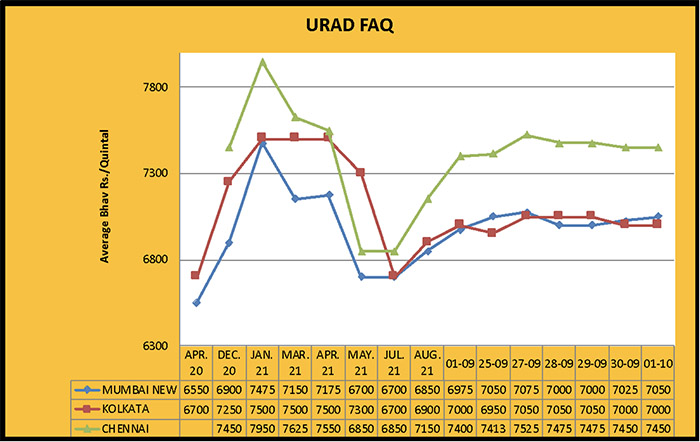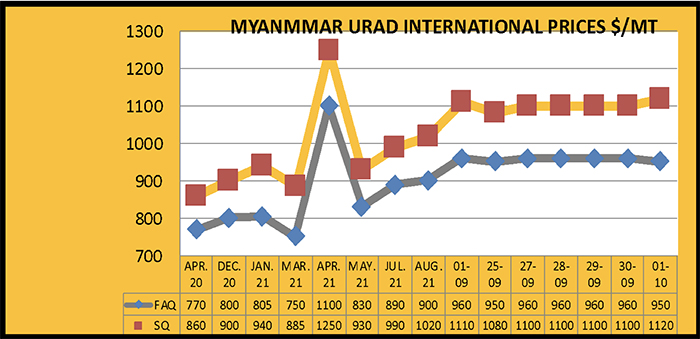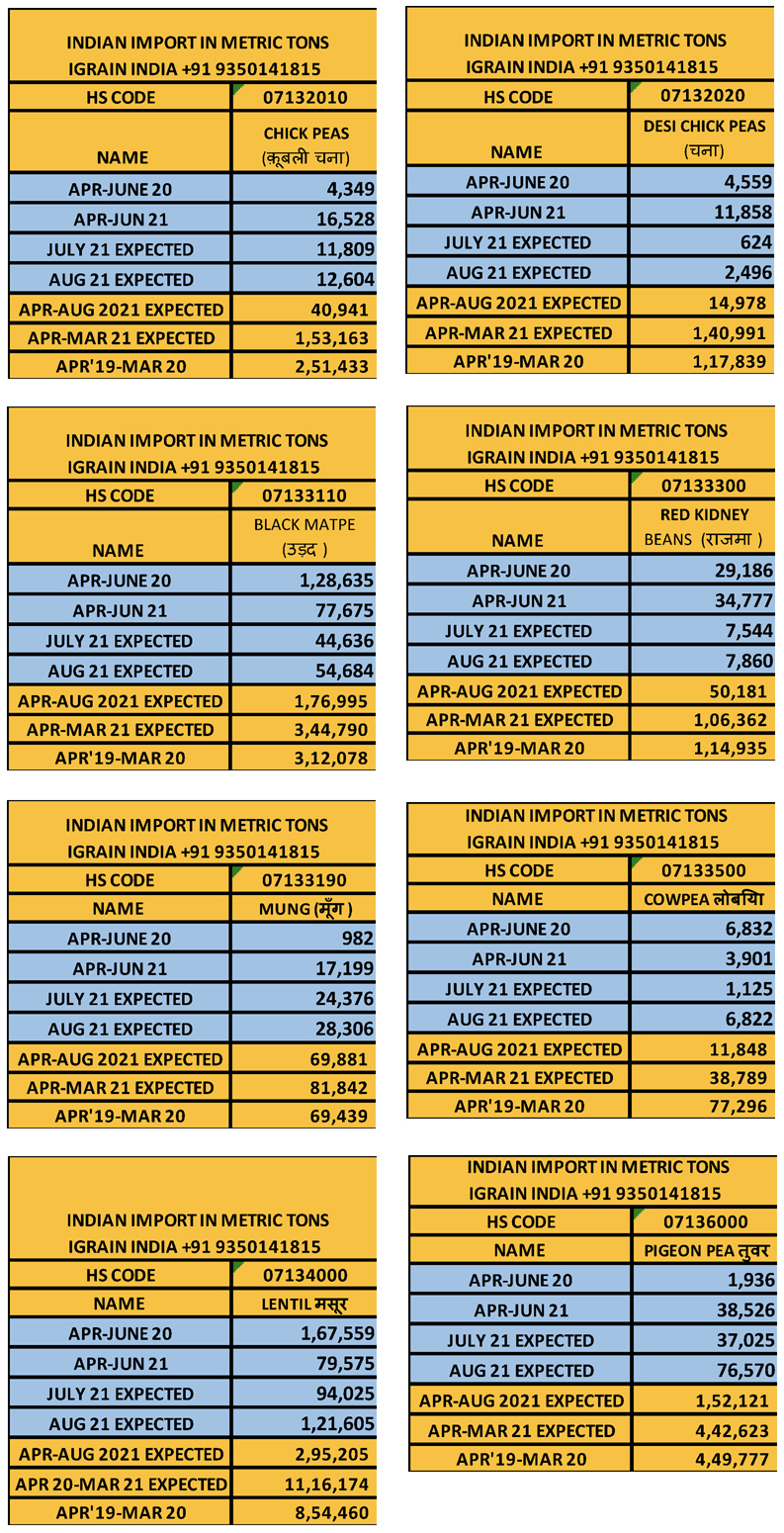
Prices up due to improved demand
Port
In Mumbai, urad has increased by Rs. 50 per quintal this week to Rs. 7,000/7,100 per quintal over the weekend, due to an improvement in demand and traded prices. Similarly, in Chennai, the FAQ urad price rose by Rs. 75 per quintal to Rs. 6,900 per quintal. The price for SQ urad recorded a drop of Rs. 50 per quintal due to weak buying and remained at Rs. 7950 per quintal over the weekend. In Kolkata, urad increased by Rs. 50 per quintal to Rs. 7,000 per quintal.
Delhi
Urad FAQ prices registered an improvement of Rs. 50 and SQ by Rs. 25 per quintal due to the impact of port's growth and increased buying and with this improvement, the FAQ prices rose to Rs. 7,250 per quintal and SQ to Rs. 8,350 per quintal over the weekend.
Maharashtra
Urad quality is affected in Maharashtra due to excess rainfall in some areas during harvesting. More arrivals of tainted/discoloured goods are coming into the mandis with high moisture content. In some parts, harvesting is delayed. In Maharashtra, prices registered a rise of Rs. 100/200 per quintal due to increased purchasing of good quality urad by stockists and millers. In Barshi, urad traded at Rs. 4,000/7,200, in Dudhni at Rs. 5,000/7,500, in Ahmednagar at Rs. 4,200/7,200 and in Jalgaon at Rs. 7,175/7,400 per quintal.
Karnataka
Due to continued demand, Karnataka prices rose by Rs. 100/150 per quintal to Rs. 4,000/7,100 in Gulbarga, Rs. 5,991/6,819 in Hubli and Rs. 3,000/7,100 per quintal in Bidar over the weekend.
Madhya Pradesh
The pressure of arrival of urad has not yet built up in the mandis of Madhya Pradesh. Due to continued buying by stockists, Ashok Nagar prices registered an increase of Rs. 100 and Ganjbasoda prices by Rs. 200 per quintal. Ashok Nagar sold out at Rs. 4,000/6,000 and Ganjbasoda at Rs. 3,000/6,500 per quintal over the weekend.
Rajasthan
Demand was normal, there was no bullish or bearish trend in Jaipur and prices remained stable at Rs. 6,800/7,400 per quintal. The daily arrival of new urad is 1,000/1,500 bags (1 bag=100kg) in the Kekdi yard and demand for the best quality urad from local mills remains strong. The best quality urad is being traded in the Kekdi yard at Rs.8000 per quintal.
Others
In Vijayawada, buying remained normal and prices remained stable at Rs. 7,600/7,800 per quintal. The daily arrival of urad in the Lalitpur Mandi of Uttar Pradesh was 3,000/3,500 sacks, up from 1,000/1,500 sacks last week. In Lalitpur, prices saw an increase of Rs. 200 per quintal this week, bringing them to Rs. 4,500/6,500 per quintal over the weekend.
Urad dal
With the support of the uptrend in urad demand, an increase of Rs. 100 per quintal was registered and prices rose to Rs. 8200/10150 per quintal in almost all markets.



In the annual meeting of the All India Dal Mill Association held in Indore on Monday, pulse traders and pulse millers from other states of the country including Madhya Pradesh and Rajasthan were present. In the meeting, information was given about the various efforts made and being done in the interest of the pulses industry through the institution. The association said that the government has asked to submit stock details in A and B ANNEXURE on the portal twice a month and added that separate information on whole pulses, lentils, and lentils without rind stock was sought in B ANNEXURE. The Food Department has issued an intensive order to give stock details and now processors and pulse millers will not be required to submit stock details in the department. Instead, it will only be mandatory to send weekly stock details to the Central Government's portal of Consumer Affairs and Food Public Distribution.
The organization raised the demand to abolish the 5% GST levied on branded pulses, saying that the price of branded pulses is too high and discourages buyers, causing losses for the mills. They also mentioned that the pulses industry should also be given an import license for the import of pulses.
Also discussed was the fact that dal millers should make a special policy on exports because pulses come to Madhya Pradesh for processing from many states on which the market fee should not be levied.
Due to rain in northern Maharashtra, the scope of damage to mung, urad and bajra crops has increased. More than 2 lakh hectares of crops were sown in Nashik, Jalgaon and Dhule, out of which the area of bajra alone is 1.3 lakh hectares. 60% of the moong and urad crops have been harvested in Nashik and Bajra harvesting will start soon. There is a possibility of damage to moong and urad crops due to rain and loss in millet is also foreseen. The maximum damage was done in the Malegaon, Nandgaon and Satna talukas of Nashik. Large quantities of tuar consignments may arrive at the port from Mozambique in October.
Increase in area of pulses crops by 0.373 million hectares
New Delhi. The latest data from the the Union Agriculture Ministry shows that in the current Kharif season, until September 24, the total area of pulses crops has increased to 14.158 million hectares at the, which is 0.373 million hectares more than the five-year average area of 13.785 million hectares. The increase comprises 0.275 million hectares more of tuar, 0.191 million hectares of mung own and 45,000 hectares of urad.
Meanwhile the area of other pulses has decreased. In some states the area of pulse cultivation was less than the normal average. There has been a decline of 0.176 million hectares in Madhya Pradesh, 57,000 hectares in Orissa, 44,000 hectares in Andhra Pradesh, 38,000 hectares in Telangana and 16,000 hectares in Tamil Nadu.
On the other hand, the pulses area has increased to 0.369 million hectares in Karnataka, 0.140 million hectares in Rajasthan, 90,000 hectares in Jharkhand, 59,000 hectares in Haryana, 34,000 hectares in Maharashtra, 26,000 hectares in Uttar Pradesh and 13,000 hectares in Bihar.
The Union Agriculture Ministry has estimated its total production to reach a height of 9.45 million tonnes, which is 8.69 million tonnes more compared to last year's production. In June, July and August, however, there was a lot of damage to the pulse crops, due to sudden changes in monsoon activity. Torrential rains in September also damaged crops in many areas. As a result, the production of pulses is likely to be much lower than the government estimate.
The weather in Rajasthan, Madhya Pradesh, Maharashtra and Karnataka, major producing states of mung, urad and tuar, was not very favorable. In some places, the crop was scorched due to low rainfall and high temperatures, while in other, there were heavy rains and floods.
Mung and urad arrivals have begun in the mandis and the tuar crop will start coming in December/January. These three pulses are being imported regularly from abroad and as a result the domestic market price has almost stabilized. The central government is also trying hard on its part to keep prices under control. The import of these three pulses has been deregulated by taking it out of the quota system and including it under the open general license system. Stock limits are also applicable for traders-stockists and pulse-millers.
Stock details of pulses in Madhya Pradesh to be uploaded directly to Union Food Ministry
The Food, Civil Supplies and Consumer Protection Department of Madhya Pradesh has made some amendments to the notification issued on July 19, 2021 by publishing a notification in the Gazette or Gazette (Extraordinary). According to the amendment made in the Madhya Pradesh Essential Commodities Traders (Control) Order, 2021, the word 'essential commodities' in the preamble of the order has been substituted for the words 'pulses and edible oil'. Form 'B' to the Commission Agent, Processor and Importer required details to be given of stock available for the fortnight ending 15th of each month up to 20th of the same month and stock available in the fortnight ending at the end of the month. The details were to be sent to the District Collector by the 5th of the next month and the receipt of the return was to be kept with him, but now this provision has been abolished.
The new provision added in its place states that every wholesaler, commission agent, processor and importer will now have to upload the details of their stock on the portal of the Department of Consumer Affairs in the Union Ministry of Food and Public Distribution within the export time period, which will be different (additional) from their stock details submitted to the Agricultural Produce Marketing Committee (Mandi). Form 'B' has therefore been removed and has thus freed traders/millers etc. from the need to send their details to the District Magistrate every fortnight and obtain a receipt. In Schedule 1 of the earlier order, the use of the word "whole or pulverized” in the category of Scheduled Commodities has also been omitted. Similarly, in Schedule II, for the word 'miller', the word 'processor' shall now be used. The words 'Pulses and Edible Oil' shall be omitted and the word 'Essential Commodities' shall be used.
Little chance of softening of pulses prices
The torrential rains in the last phase of the south-west monsoon are causing significant damage to the Kharif pulses crops, while the festive demand for other pulses, including gram, is likely to pick up in the coming days. There is less import of tur and lentils in the country while import of gram and peas has almost stopped. The Kharif season mung and urad crops are being affected to a great extent by natural calamities in the major producing states, and spot stocks are not extensive. Due to rain and waterlogging in the fields, there is a possibility of deterioration of the grain quality of pulses, due to which there may be a shortage of good quality goods.
Although the central government has estimated the total production of pulses to reach 9.45 million tonnes in the current Kharif season, which is 0.75 million tonnes more than last year's production of 8.7 million tonnes, industry-trade critics believe that the actual production will be more like 8 million tonnes. In Canada and Australia, the price of lentils has already jumped to a very high level, meaning imports are bound to be expensive. The Indian government has fixed the import duty of lentils for these countries from 30 percent to 10 percent, but this will not help much in controlling the domestic market price. Similarly, import of tuar from African countries will be possible only after October. The prices of urad, mung and tuar have increased in Myanmar.
In India, the new crop of tuar will be ready in December/January and will start arriving in the mandis, while the crop of urad and mung has been damaged. On the whole, it appears that the domestic market price of pulses and pulses will not soften much in the near future but there is nevertheless some scope for an increase. Stockists and pulse millers are acting cautiously in the business as stock limits are applicable on gram, tuar, urad and lentil. The import of tuar, urad and mung has been deregulated but no effect is being seen yet. The market may turn a bit more bullish if the festive season sees good demand. After that, the season of marriage (Lagnasara) will start.


Andhra Pradesh, Kharif sowing/crop and rain status
Telangana Rain Kharif Crop & Sowing Status
Abbreviations
Tuar/ Arhar: Pigeon Peas PP
Mung: Green Mung
Urad: Black Matpe
Chana: Gram, Desi Chickpea
Matar: Pea
Masur: Lentil
Mandi: Market yard
Bhav: Prices
Dal/Daal: Processed Pulses (Directly for human consumption)
Rs: Indian Rupees (1$=Rs 74.54)
Rahul Chauhan
Director, IGrain India
igrainind@gmail.com
+91 9350141815
Twitter igrain_india

IGrain / Rahul Chauhan / Urad / Lentil / Mumbai / Delhi / Maharashtra / Karnataka / Madhya Pradesh / Rajasthan / Haryana / Bihar / Uttar Pradesh / Tamil Nadu / Mung / India / Canada / Australia / Chickpeas / Desi Chick Peas / Black Matpe / Mung / Red Kidney / Cowpea / Lentil / Pigeon Pea
Disclaimer: The opinions or views expressed in this publication are those of the authors or quoted persons. They do not purport to reflect the opinions or views of the Global Pulse Confederation or its members.